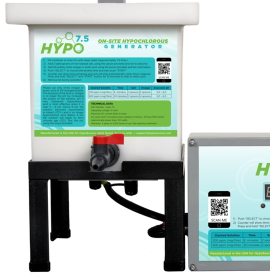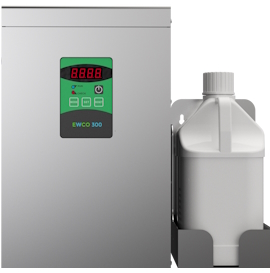अनुसंधान > उद्यम > Water > प्रयोग : All
हाइपोक्लोरस तेज़ाब के घोल के सामान्य नाम
- Electrolytically Generated Hypochlorous Acid
- Neutral Electrolyzed Water (NEW)
- Electrolyzed Oxidizing Water (EOW)
- Electro-chemically Activated Water (ECA)
- Super-oxidized water (SOW)
परिणाम : 6 प्रकाशित लेख

Microbe(s): Coronavirus
This study has focused attention on the coronavirus countermeasures becathe sterilizing effect demonstrated in the condominium Spring water of hypochlorite water processed from mineral water of Soleil Taruis hardness 93 pH 6.63 is effective as a countermeasure against coronavirus. Publish details of hypochlorite water treatment as demonstrated in the water case study report.

Microbe(s): None
In this study, the anaerobic digestion of thermally hydrolyzed wasted sludge (THWS) with a high concentration of ammonia was carried out through combining with an ammonia stripping and an electrolyzed water system (EWS). The EWS produced acidic water (pH 23) at the anode and alkaline water (pH 1112) at the cathode with an electro-diaphragm between the electrodes that could be applied to ammonia stripping. The ammonia stripping efficiency was strongly dependent on the pH and aeration rate, and the ammonium ion removal rate followed pseudo-first-order kinetics. From the BMP test, the methane yield of THWS after ammonia stripping using the EWS was 2.8 times higher than that of the control process (raw THWS without ammonia stripping). Furthermore, both methane yield and ammonium removal efficiency were higher in this study than in previous studies. Since ammonia stripping with the EWS does not require any chemicals for pH control, no precipitated sludge is produced and anaerobic microorganisms are not inhibited by cations. Therefore, ammonia stripping using the EWS could be an effective method for digestion of wastewater with a high concentration of ammonium nitrogen.

Microbe(s): Total Microbial Count
This section covers peculiarities of so-called in-line electrolysis when drinking water is electrolysed to produce disinfection species killing microorganisms. Mainly mixed oxide electrodes (MIO) based on IrO2 and/or RuO2 coatings and boron-doped diamond electrodes were used in the studies. Artificial and real drinking water systems were electrolysed in continuous and discontinuous operating mode, varying water composition, current density and electrode materials. Results show, besides the ability of producing active chlorine, risks of inorganic disinfection by-products (DBPs) such as chlorate, perchlorate, nitrite, ammonium, chloramines, hydrogen peroxide and others. DBPs are responsible for analysis errors using DPD method for active chlorine measurements. Geometry may influence by-product yield. As a conclusion, the necessity of developing test routines for practical cell applications must be underlined.

Microbe(s): Escherichia coli O157: H7
To evaluate the potential of using electrolyzed oxidizing (EO) water for controlling Escherichia coli O157:H7 in water for livestock, the effects of water source, electrolyte concentration, dilution, storage conditions, and bacterial or fecal load on the oxidative reduction potential (ORP) and bactericidal activity of EO water were investigated. Anode and combined (7:3 anode:cathode, vol/vol) EO waters reduced the pH and increased the ORP of deionized water, whereas cathode EO water increased pH and lowered ORP. Minimum concentrations (vol/vol) of anode and combined EO waters required to kill 104 CFU/ml planktonic suspensions of E. coli O157:H7 strain H4420 were 0.5 and 2.0%, respectively. Cathode EO water did not inhibit H4420 at concentrations up to 16% (vol/vol). Higher concentrations of anode or combined EO water were required to elevate the ORP of irrigation or chlorinated tap water compared with that of deionized water. Addition of feces to EO water products (0.5% anode or 2.0% combined, vol/vol) significantly reduced (P < 0.001) their ORP values to <700 mV in all water types. A relationship between ORP and bactericidal activity of EO water was observed. The dilute EO waters retained the capacity to eliminate a 104 CFU/ml inoculation of E. coli O157:H7 H4420 for at least 70 h regardless of exposure to UV light or storage temperature (4 versus 24 C). At 95 h and beyond, UV exposure reduced ORP, significantly more so (P < 0.05) in open than in closed containers. Bactericidal activity of EO products (anode or combined) was lost in samples in which ORP value had fallen to 848 mV. When stored in the dark, the diluted EO waters retained an ORP of >848 mV and bactericidal efficacy for at least 125 h; with refrigeration (4 C), these conditions were retained for at least 180 h. Results suggest that EO water may be an effective means by which to control E. coli O157:H7 in livestock water with low organic matter content.

Microbe(s): None
An electrolytic process based on chlorine generation was adopted to treat wastewater containing textile dyes. In situ production of hypochlorous acid was achieved in an undivided electrolytic cell. The cell contained a graphite rod as the anode and a stainless steel sheet as the cathode. The generated chlorine reacts with water leading to the formation of hypochlorous acid and hydrochloric acid. The resultant hypochlorous acid, being an oxidising agent, oxidises the organic components present in the textile wastewater. In this study, the colour in wastewater containing Procion Navy and Procion Red dyes, respectively, was completely removed after 40 min of electrolysis at a constant current density of 39 mA/cm2 (where the initial dye concentrations were 3700 and 3200 mg/l, respectively). In the case of the Procion Yellow and composite dyes, complete colour removal occurred after 50 min of electrolysis (with initial dye concentrations of 3500 mg/l). Even though colour removal occurred during the electrolysis process, it required up to 180 min of electrolysis to reduce the COD values for the four dyes (Procion Navy, Red, Yellow and the composite) from the initial levels of 4520, 4200, 4170 and 4283 mg/l to 70, 45, 39 and 52 mg/l, respectively. This clearly indicates that the process removes both colour and organic components present in textile wastewater.

Microbe(s): Viruses, Hepatitis B Virus, HIV
Electrolyzed products of sodium chloride solution were examined for their disinfection potential against hepatitis B virus (HBV) and human immunodeficiency virus (HIV) in vitro. Electrolysis of 0.05% NaCl in tap water was carried out for 45 min at room temperature using a 3 A electric current in separate wells installed with positive and negative electrodes. The electrolyzed products were obtained from the positive well. The oxidation reduction potential (ORP), pH and free chlorine content of the product were 1053 mV, pH 2.34 and 4.20 ppm, respectively. The products modified the antigenicity of the surface protein of HBV as well as the infectivity of HIV in time- and concentration-dependent manner. Although the inactivating potential was decreased by the addition of contaminating protein, recycling of the product or continuous addition of fresh product may restore the complete disinfection against bloodborne pathogens.
Best Hypochlorous Acid (HOCL) Generators
 Portable Hypochlorous Acid (HOCL) Machine
Portable Hypochlorous Acid (HOCL) Machine
Make high quality hypochlorous acid in the home or office.
$159.99 + Free Shipping
 HOCL Machine + Electrostatic Sprayer
HOCL Machine + Electrostatic Sprayer
Make hypochlorous acid and spray with an electrostatic cold fogger.
$309.98 + Free Shipping


